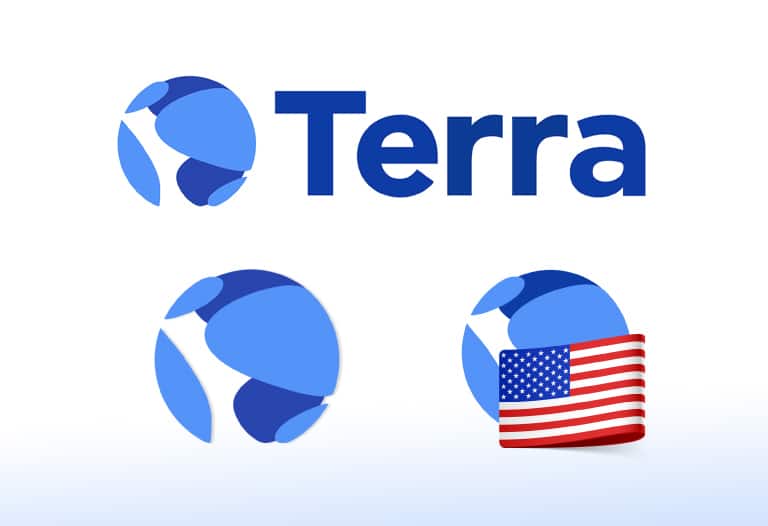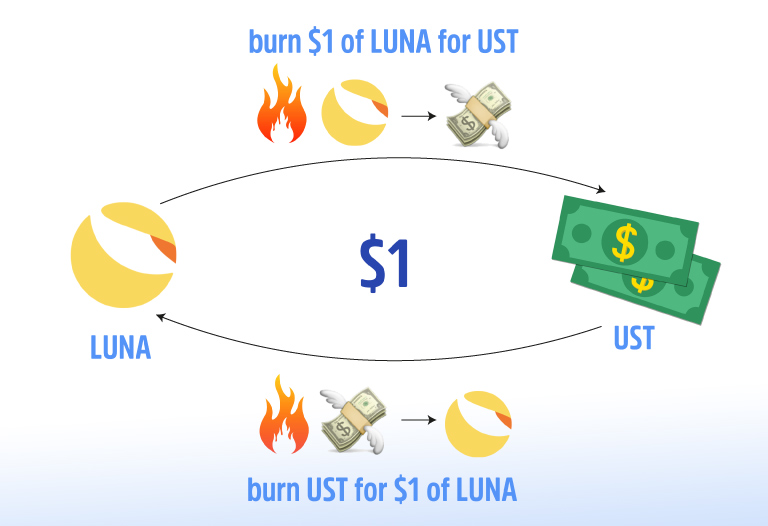
Table of Contents
ToggleA decentralized world needs decentralized money. A decentralized world needs decentralized money. Simple yet powerful is the presentation that usually introduces UST.
With almost as many supporters and advocates as it has enemies and detractors, UST is making its way into the crypto ecosystem by dint of adoption, use cases and a huge growth in its market capitalization.
What cannot be denied is that it has become an extremely important player. And it is for these reasons, in this article, I will go over everything about Terra’s stable, decentralized and algorithmic currency.
What is UST?
UST is a stable, decentralized and algorithmic cryptocurrency created on the Terra blockchain. UST was created with the goal of spreading throughout the crypto ecosystem and becoming the most widely used stablecoin in the world.
According to Terra’s blockchain creator, Do Kwon, crypto adoption will be through stable coins and UST was created to be the standard bearer to lead this mass adoption.
But, now it is our turn to understand the first sentence, in which we define UST. Let’s move on to it.
What does it mean for UST to be a stablecoin?
When we say that UST is a “stablecoin”, or a stable currency, we mean that its price is “pegged” to the price of the dollar. Thus, instead of exposing our capital to currencies whose price is so volatile (as the market determines through buying and selling), with UST we can protect ourselves in a currency in which each unit will always tend to be worth one dollar.
Now, for UST to tend to maintain this quotation, two factors are necessary:
-
- An asset, asset or basket of assets that give value to this stablecoin.
- A mechanism to adjust or maintain the “peg” or correlation with the dollar in times of volatility.
The first aspect gives UST its “decentralized” character and the second positions it as “algorithmic”. Let us continue with these characteristics.
UST, the decentralized stablecoin
In the world of stable currencies, there are two main groups:
-
- Centralized
- Decentralized
- Centralized
The difference lies in how these currencies create or acquire the financial “back up” that allows them to reach 1-to-1 parity, whether with the dollar or another FIAT currency, and of course, by who is behind them.
Centralized Stablecoins
The most famous and powerful in this area are three:
This order responds to their market capitalization. With small differences in terms of the preparation of their treasury or economic backing, these currencies are centralized by companies that ensure that for each unit issued they have one dollar deposited in a bank account or an asset that represents this value. An example in this sense are the American treasury bonds.
To issue one of these currencies, it is necessary to contact these companies, send the money necessary to issue them and the companies will be in charge of the custody of the bills or bonds that support this creation.
The biggest risk they pose, due to their centralized nature, comes from the possibility of censorship that these companies have over these “stablecoins” and we have seen that power in action more than once.
Decentralized Stablecoins
This type of stable coin fills all the boxes that a crypto-user, faithful to the primordial principles of this ecosystem, can demand:
-
- There is no company behind them
- No one has to be asked for permission to broadcast it.
- Its value is backed by other cryptocurrencies
In this exclusive club, we have UST as the queen in terms of market capitalization and DAI as the pioneer, the one that opened and marked a path and a standard to follow.
DAI derives its value from different cryptocurrencies, enabled by its own community, which are locked into smart contracts to, according to strict security parameters, issue this stablecoin.
As for UST, its method of issuance is somewhat different and is given by the mechanism behind the birth of each unit of Terra’s stablecoin.
I develop it below.

UST, the algorithmic stablecoin
Finally, it is our turn to soak up the most relevant feature of UST, if we take as a parameter the noise it has generated around it. Half of the crypto library tells us that this is its weakest point, while the other half highlights this property as the most important.
Before taking a position, we need to know how each new UST unit is created and how its mechanism works, in charge of sustaining the famous “peg” or parity with the dollar.
How is UST created?
UST is a stable decentralized currency. Like DAI it does not require a dollar in a bank account or the permission of a company to be issued, but unlike DAI there is no variety of cryptocurrencies that, by means of blocking in a smart contract allow to create it. Here, only LUNA counts.
To create a new UST it is necessary to burn the same amount, in nominals, of LUNA. What does this tongue twister mean? Examples will save us from the nitty-gritty:
-
- If LUNA trades at $100, to create 100 units of UST we must “burn” 1 unit of LUNA.
- With LUNA trading at 100, to create 10 units of UST we must “burn” 0.1 units of LUNA.
- With LUNA trading at 100, to create one unit of UST we must “burn” 0.01 units of LUNA.
Now, how does this work in practice? Simple, in the main wallet of the Terra network, Terra Station, in the “Swap” section, we select the LUNA-UST pair and the “Market” option. When the swap is performed, these LUNA will be “burned” or, in other words, removed from the market.
The logical question is, how do we know that UST will always tend to be worth a dollar? Thanks to an algorithm.
How does UST maintain the value of a dollar?
The manner in which UST maintains its “peg” has given rise to great and lengthy discussions.
UST and its volatility
In the month of May 2021, when bitcoin with its brutal fall, dragging the crypto-market into the abyss, UST lost its parity with the dollar for a few days. The problem came from the hand of the speed of reaction of its algorithm.
Let us understand what happened and what measures were taken so that this situation does not happen again.
UST and LUNA coexist in a mutual relationship in which the balance of Terra’s network is centered. LUNA is used to create UST. As more LUNA is burned, it becomes scarcer and its price, if required, increases, so it is said that LUNA captures the market value of UST. But what happens when the scenario is the opposite?
May 2021 and its consequences
When the price of LUNA drops violently, as it did last May, or when users want to get rid of their USTs, the effects are the opposite. Users may “burn” their USTs to redeem them for LUNA and to supply this demand it is necessary to issue more LUNA.
Terra’s algorithm is in charge of detecting these imbalances and propelling LUNA’s issuance through the network validators. This mechanism, together with UST’s price arbitrage, is what sustains its “peg”.
Post-May modifications
Following the May collapse of the previous year, the network was upgraded to allow validators to issue LUNA more quickly in order to absorb the oversupply of USTs.
To date, LUNA has been hit by sharp declines while UST has endured with minimal volatility and an effective parity with the dollar proving the value of the changes undertaken.
Luna Foundation Guard and its mission
In this sense, in January 2022, a non-profit foundation was born under the name of Luna Foundation Guard. Its mission is to protect Terra’s ecosystem and work towards its expansion.
Among its most significant measures is the creation of a reserve of decentralized currencies to support UST in the event of extremely sharp market movements. The first member of this reserve is none other than the largest and oldest decentralized currency on the market, BTC.
With decisions like this, LFG (the foundation), aims to take pressure off LUNA when it comes to support a “run” in which many users want to get rid of their USTs, adding the possibility of redeeming them for these cryptocurrencies, without compromising the main feature of UST, its decentralization and its impossibility of being censored.
Today, the reserve holds one trillion, or one billion, dollars in bitcoin. LFG’s intention is to continue adding these types of coins, as an exogenous reserve to Terra’s own ecosystem, to avoid what many critics have argued as the network’s great weakness, that its entire balance depends solely and exclusively on LUNA.

The source of UST’s success
UST’s growth has been phenomenal. Beyond the philosophy behind this stable coin, it is partly due to its use cases. Undoubtedly, the two largest sources of demand for this currency are:
-
- Anchor and its famous stable interest rate, which floats between 17 and 22% per annum.
- Ozone, Terra’s network insurance
First of all Anchor, the famous application of this blockchain, concentrates more than 9 billion UST. Considering that the current market capitalization of this stablecoin is 14 billion, we cannot deny that Anchor is the main source of demand for UST.
On the other hand, Ozone, a platform dedicated to securing Terra’s network applications through “quadratic financing,” has about $3 billion more in its coffers.
Undoubtedly, these are the main catalysts for UST’s “bestial” growth. But we cannot fail to highlight the growth that, in the first place, comes from Terra’s own applications, its real-world use cases and UST’s great expansion into new networks.
Beyond the confines of the Cosmos ecosystem, Ethereum, Avalanche and Solana are the networks leading the way in “outsider” UST consumption.
Function, philosophy and adoption
Traversing the winding and violent waters of the crypto market, being the subject of incisive disparagement and vociferous praise, UST has, in a short time, positioned itself as the fourth stable coin in terms of market capitalization.
If we focus on the decentralized group, it took the position that DAI had occupied for years, as the first one. UST is, among the most important, the only stablecoin that cannot be censored. DAI gave up this characteristic by accepting centralized stablecoins as collateral.
The goal that gave birth to UST was to be a leader in the world of stable coins, spreading without limits through the crypto ecosystem and boosting adoption through real use cases. The first steps, have been firmly taken, it is a matter of time to know if its goals will be

